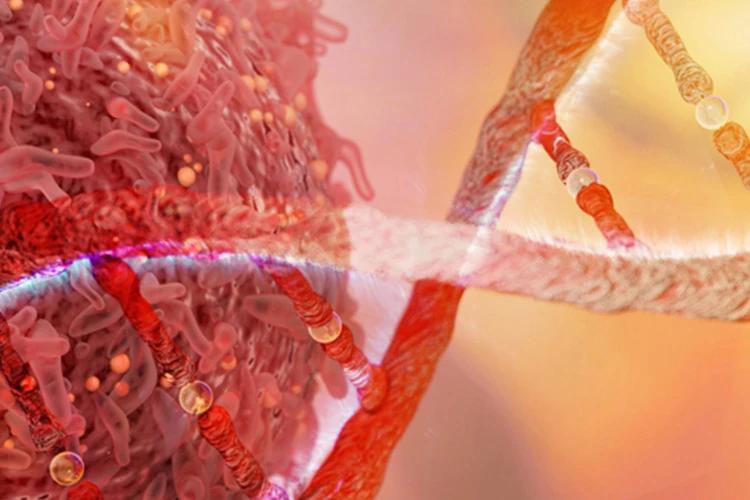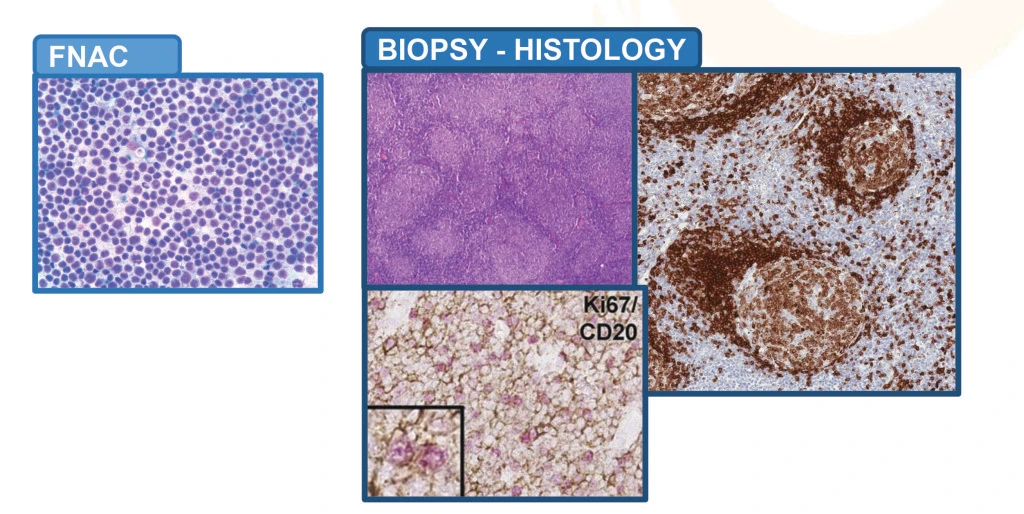Non-Hodgkin Lymphoma

Lymphoma is a type of blood cancer involving the lymphatic tissues where the normal lymphocytes become cancerous. The type of lymphocyte and at which stage of the lymphocyte life cycle determines the type of lymphoma. The two main groups are Hodgkin Lymphoma (HL) and Non-Hodgkin’s Lymphoma (NHL). The Non-Hodgkin’s Lymphoma group can be divided into T-cell, B-Cell, and NKT-cell Lymphoma. The B Cell Lymphomas are usually further subdivided into slow-growing (low grade) and aggressive (high grade) lymphoma.
Accurate diagnosis of the exact type of lymphoma is the most important first step to receive effective treatment.
The reason why some patients develop lymphoma and others do not is not clear. However, several factors are known to be associated with the development of lymphoma. These factors include viruses like HIV (Human Immunodeficiency Virus), Epstein Barr Virus (EBV), HTLV-1 and HHV-8. Other possible factors include environmental carcinogens and certain rare genetic disorders.

While Non-Hodgkin’s Lymphomas can present with a large variety of symptoms, the common symptoms are:
- Prolonged and recurrent fevers
- Unexplained weight loss
- Swollen lymph glands that can be felt in the neck, under arm, and groin regions
- Night sweats
- Loss of appetite
Having these symptoms does not mean that someone has lymphoma. In fact, most times these symptoms are not due to cancer. However, anyone with such symptoms should see a doctor to be diagnosed appropriately and treated if needed.

How is Diagnosis made?
A biopsy of the affected lymph glands is essential for the diagnosis of lymphoma. This can be in the form of an incision biopsy (small piece of lymph node tissue) or excision biopsy (removal of one entire lymph node). Fine needle aspiration alone (where a needle is inserted into the affected lymph gland to draw cells out for examination) should not be used for diagnosing lymphoma. The biopsy tissue obtained is subjected to special stains that allow accurate classification of the lymphoma type.
Staging
Once the diagnosis of Non-Hodgkin’s Lymphoma is confirmed, a staging assessment has to be done. Staging refers to the extent of the lymphoma in the body. This often carries prognostic significance and is very useful to help develop treatment plans for the patient. There are 4 stages (Stage I to IV) as well as a A or B category.
The various stages are as follows:
- Stage I: One group of affected lymph nodes on either side of diaphragm.
- Stage II: Two or more groups of affected lymph nodes but still on only 1 side of the diaphragm.
- Stage III: At least 2 groups of affected lymph nodes but must be on both sides of the diaphragm.
- Stage IV: If there is disease affecting an organ (e.g. Bone Marrow, Liver etc.) other than lymph nodes.
- Stage A: Absence of recurrent fevers, night sweats or weight loss.
- Stage B: Presence of any one of the above.
Staging involves imaging with PET-CT or CT-scans. Depending on the scenario, further tests like bone marrow biopsy or cerebrospinal fluid assessment are carried out.
The prognosis is not solely dependent stage of the disease. In this era of targeted therapies, immunohistochemical assessment of the biopsy tissue also gives important prognostic information.
Treatment may involve any of the following modalities, chemotherapy, radiotherapy, immunotherapy and stem cell transplant. Very often, it is likely a combination of 2 or more of the above modalities. This is dependent on the subtype of lymphoma and various prognostic features of the lymphoma.
Chemotherapy
Chemotherapy drugs are also known as cytotoxics. In general, these drugs kill cells that rapidly divide/ grow. Thus, cytotoxics are highly effective for killing cancer cells but will also damage normal cells of the body which divide rapidly like the hair follicles and normal blood-forming cells in the bone marrow. These effects manifests as hair loss and temporary declines in blood cells (like red blood cells, white blood cells, platelets). Chemotherapy is often combined with monoclonal antibody therapy in Non-Hodgkin’s Lymphoma.
Immunotherapy
Immunotherapy is treatment that uses the patient’s own immune system, or medications made from components of the immune system, to fight the disease. There are many forms of immunotherapy. In the case of Non-Hodgkin’s Lymphoma the main form is with monoclonal antibodies (also known as ‘biologics’). In the most common form of Non-Hodgkin’s Lymphoma, an entity known as diffuse large B-cell lymphoma, the combination of monoclonal antibody and chemotherapy is the mainstay of treatment. This combination of also used in other types of Non-Hodgkin’s Lymphoma.
There are different monoclonal antibodies that target different proteins and therefore different types of lymphoma cells. Because of the specificity of these drugs, there is no ‘one size fits all’ when using these treatments and careful selection of the appropriate therapy according to the Non-Hodgkin’s Lymphoma type is crucial.
Apart from monoclonal antibodies, other immunotherapies including checkpoint inhibitors are also used but usually in the setting of relapsed disease.
Stem Cell Transplantation
A person with recurrent lymphoma may receive stem cell transplantation, usually as second-line treatment. A transplant of blood-forming stem cell allows a person to receive high doses of chemotherapy, radiation therapy, or both. The high doses destroy both lymphoma cells and healthy blood cells in the bone marrow. Later, the patient receives healthy blood-forming stem cells through a flexible tube placed in a large vein in the neck or chest area. New blood cells develop from the transplanted stem cells.
Stem cell transplants take place in the hospital. The stem cells may come from the patient’s own self or from a healthy donor.
Radiation Therapy
Radiation therapy (also called radiotherapy) uses high-energy rays to kill Non-Hodgkin’s Lymphoma cells. It can shrink tumours and help control pain. Radiation is also sometimes used in the first-line therapy in patients with stage I or stage II disease, where the lymphoma is localised to one region or one side of the diaphragm.

CanHOPE is a non-profit cancer counselling and support service provided by Parkway Cancer Centre, Singapore. CanHOPE consists of an experienced, knowledgeable and caring support team with access to comprehensive information on a wide range of topics in education and guidelines in cancer treatment.
CanHOPE provides:
- Up-to-date cancer information for patients including ways to prevent cancer, symptoms, risks, screening tests, diagnosis, current treatments and research available.
- Referrals to cancer-related services, such as screening and investigational facilities, treatment centres and appropriate specialist consultation.
- Cancer counselling and advice on strategies to manage side effects of treatments, coping with cancer, diet and nutrition.
- Emotional and psychosocial support to people with cancer and those who care for them.
- Support group activities, focusing on knowledge, skills and supportive activities to educate and create awareness for patients and caregivers.
- Resources for rehabilitative and supportive services.
- Palliative care services to improve quality of life of patients with advanced cancer.
The CanHOPE team will journey with patients to provide support and personalised care, as they strive to share a little hope with every person encountered.
